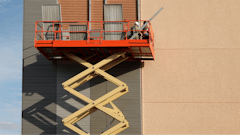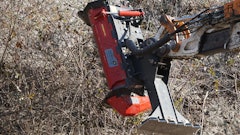
Lithium Ion (aka Li-Ion) technology has been around awhile. These rechargeable batteries have been powering consumer electronics - laptops, digital cameras, cell phones and more - for years, but recently these batteries have moved into the cordless power tool market.
"From professional contractors to serious DIYers, Li-Ion battery technology is proving to be one of the biggest innovations in nearly 20 years," says Edwin Bender, product manager, LITHEON cordless power tools, Bosch Power Tools & Accessories. "It could arguably be the biggest innovation the industry has experienced to date."
For years, power tool users have relied on 18-volt NiCad batteries as the primary source for powering cordless tools. "For most cordless tools - drill/drivers, rotary hammers, reciprocating saws, circular saws, jig saws, miter saws and more - 18-volt NiCad was the best balance between performance, weight and price," says Bender. "But like any technology, professionals continue to demand more powerful, efficient and comfortable tools."
Enter Li-Ion technology.
Less weight
There are several major benefits of Li-Ion-powered tools: less weight, longer runtime, "fade-free" power and longer life expectancy.
"Lithium Ion batteries are much lighter than NiCads," says John Fries, product manager - cordless, woodworking and bench top tools with Hitachi Power Tools. "In the 18-volt platform, this technology takes about a pound off of each tool."
This also means you can get increased power in a smaller package. An individual NiCad battery can hold 1.2 volts, while a single Li-Ion cell can hold and use up to 3.6 volts and still weigh less than a NiCad cell.
This, says Bender, means a Li-Ion cell can either hold more power in the same size package or hold the same power in a smaller package. "Less weight combined with compact size and more power make Li-Ion tools easier to handle and more productive, which is a major advantage."
Longer runtime
When it comes to more runtime, any increase in voltage for any battery will increase runtime. So, by increasing Li-Ion batteries to a higher voltage, such as 36 volts, users will get a runtime increase. But like NiCad, runtimes are based on whether a particular application might draw more power than another.
"But, overall, the larger the voltage, the more runtime the user can expect," says Bender. "Moving forward, 36-volt batteries are the highest voltage the market will likely see for power tools."
Bosch offers a unique system that allows users to customize their tools based on weight and runtime. The 36V Flexible Power System (FPS) gives the option of two different task-specific 36-volt battery packs - the SlimPack and the FatPack. The SlimPack is ideal for one-handed and overhead applications; the FatPack is designed for heavy-duty extended usage applications.
"Fade-free" power
"'Fade-free' power means the first cut is as good as the last," says John Sara, senior product manager with Milwaukee Electric Tool.
This steady stream of power allows Li-Ion-powered tools to offer a consistent level of performance from the beginning to the end of the discharge cycle. It also allows for the ability to recharge the battery at any time without causing memory effect, which is when a battery will no longer charge to full capacity after being partially charged and discharged a series of times.
"So, whether 20- or 99-percent charged, a user can recharge the battery to full anytime without causing cell damage," says Bender.
Longer life expectancy
A big advantage of Li-Ion tools for rental businesses is the longer life expectancy. "Li-Ion batteries offer more charge cycles than NiCad," says Sara. "And a few manufacturers, like Milwaukee, back their packs with a five-year warranty compared to a one-year for NiCad."
Fries says you can expect almost three times more life out of a Li-Ion battery versus a NiCad. He notes that NiCad batteries start to immediately discharge as soon as it's released from the charger. But a Li-Ion battery doesn't have this drastic discharge, which means they offer longer shelf life too, a great benefit to rental businesses.
"Rental businesses will be able to store these tools on the shelves for a couple of weeks between rentals, and not have to worry about losing the charge," says Fries.
The cost factor
With all these great advantages, what are the disadvantages of Li-Ion tools?
"There really are none," says Fries. "The cost is a little more. But when you understand that you get three times more life for about 20 percent more cost, there's really no comparison."
All the sources agree that over time, as Li-Ion populates the market, the price differences between the two types will shrink.
"There's an adoption curve right now," says Bender. "I believe Li-Ion will overcome NiCad, then you'll see the prices become even; Li-Ion will probably even cost less than NiCad at some point."
That Li-Ion tools cost more than NiCad can be seen as a positive by rental businesses, says Sara with Milwaukee. "Some customers may prefer to try several platforms before making a purchase," he explains.
Adds Fries, "Users can try the 'hype' and test it before they buy. This puts rental businesses in a great position, as they can rent the tool then sell it to them when they're ready to buy."
What's the future?
Sources say that Li-Ion battery technology is the future of the power tool industry. "Tools ... will continue to become smarter and more powerful, and batteries will continue to last longer and complete more work per charge," says Sara with Milwaukee.
This doesn't mean that NiCad is going to disappear.
"You'll have two types of customers," says Bender. "The price-conscious ones, who will go with NiCad, and the others who will recognize the value and benefits of Li-Ion. So NiCad isn't going to go away."
To make it easier for rental businesses to offer both Li-Ion and NiCad options to its customers, manufacturers are offering several features to allow those who already own NiCad tools to upgrade to Li-Ion. For example, Hitachi offers a universal charger that can recharge both NiCad or Li-Ion batteries, as well as Nickel Metal Hydride (NiMH) batteries.
Hitachi also offers backwards compatibility with its HXP batteries; Milwaukee offers something similar with its V18 battery system. These allow those who already own NiCad-powered tools to use Li-Ion technology in its place.
As far as how far Li-Ion technology can go, Bender with Bosch says its really only in its infancy. Right now several manufacturers are continuing to expand their voltage offerings, meaning we could see cordless power tools with higher voltages and productivity as great as their corded cousins.
"As this technology is refined, we'll have the ability to do things with cordless tools that we've never been able to do," says Bender.





























